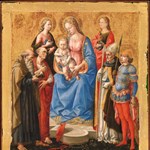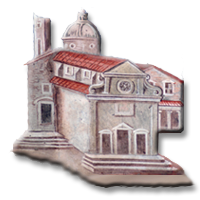Francesco di Stefano (Pesellino)
Madonna e Bambino con sei Santi
- Roma, giovedì 24 luglio 2014 07:53
- ·Segreteria
- ·Opere
Scheda di approfondimento
Pesellino specialized in delicately executed small-scale paintings. Despite their small size, the figures in this exquisite panel are constructed with a mastery that opens a new chapter in Florentine painting. Left to right the saints are: Anthony Abbot, Jerome, Cecilia, Catherine of Alexandria, Augustine, and George. The painting dates from the late 1440s and shows, in the figure types and lighting, the influence of Fra Filippo Lippi, with whom Pesellino occasionally collaborated.
| Titolo | Madonna e Bambino con sei Santi |
| Sottotitolo | |
| Artista | Francesco di Stefano (Pesellino) |
| Note artista | |
| Datazione | |
| Committente | |
| Tipologia | |
| E' un insieme? | No |
| Opera di riferimento | |
| Tema |
| Dimensioni | 22.5 x 20.3 cm |
| Materiali | Tempera su legno con fondo oro |
| Stemmi | |
| Punzoni | |
| Iscrizioni | |
| Stato di conservazione | |
| Info sui restauri |
Non ci sono attualmente documenti a disposizione.
J[oseph]. A[rcher]. Crowe and G[iovanni]. B[attista]. Cavalcaselle. Geschichte der italienischen Malerei. 3, Leipzig, 1870, p. 103, reject the traditional attribution to Fra Angelico and call it a work by Pesellino; identify Saint Jerome to the left of the Madonna and note the influence of Filippo Lippi.
Exhibition of Works by the Old Masters and by Deceased Masters of the British School. Exh. cat., Royal Academy of Arts. London, 1887, p. 47, no. 204, attributes it to Pesellino and identifies the male saints as "St. Jerome and a monk on the l[eft]., and St. Michael and a bishop on the r[ight].".
Exhibition of Early Italian Art from 1300 to 1550. Exh. cat., New Gallery. [London], 1893–94, p. 21, no. 107, describes the figures around the Madonna and Child as "two angels behind; on the left stand St. Anthony and St. Jerome, and on the right St. Louis of Toulouse and St. George and two female Saints".
Costanza Jocelyn Ffoulkes. "Le esposizioni d'arte italiana a Londra." Archivio storico dell'arte 7 (1894), pp. 156, 158, rejects the attribution to Pesellino and assigns it to Benozzo Gozzoli.
J[ean]. P[aul]. Richter. "Die Ausstellung italienischer Renaissancewerke in der New Gallery in London." Repertorium für Kunstwissenschaft 17 (1894), p. 240, rejects the attribution to Pesellino and considers it an early work by Benozzo Gozzoli.
Bernhard Berenson. The Florentine Painters of the Renaissance. New York, 1896, p. 124, lists is as by Pesellino.
Hans Mackowsky. "Die Verkündigung und die Verlobung der Heiligen Katharina von Francesco Pesellino." Zeitschrift für bildende Kunst, n.s., 10 (1898–99), pp. 83–84, fig. 2, attributes it to Pesellino and identifies a drawing in the Musée du Louvre, Paris [see Notes], as a preparatory study for the bishop saint on the right, whom he tentatively calls Louis of Toulouse; identifies the remaing male saints as Anthony, Jerome, and George
.
Mary Logan. "Compagno di Pesellino et quelques peintures de l'école (2e article)." Gazette des beaux-arts, 3rd ser., 26 (October 1901), p. 342 n.1.
Mary Logan. "Compagno di Pesellino et quelques peintures de l'école (1er article)." Gazette des beaux-arts, 3rd ser., 26 (July 1901), p. 23, attributes it to Pesellino.
Werner Weisbach. Francesco Pesellino und die Romantik der Renaissance. Berlin, 1901, pp. 68–69, 130, pl. XI, attributes it to Pesellino, calls the drawing in the Louvre [see Ref. Mackowsky 1898–99] a preparatory study, and tentatively identifies the bishop saint as Louis of Toulouse.
Bernard Berenson. "A Miniature Altar-Piece by Pesellino at Empoli." Revue archéologique 40 (January–June 1902), p. 194.
Bernhard Berenson. The Drawings of the Florentine Painters. London, 1903, vol. 1, p. 55–57 nn.; vol. 2, p. 129, under no. 1847, calls it an early work by Pesellino influenced by Filippo Lippi and Domenico Veneziano; considers the Louvre drawing a copy after the figure of Saint Augustine.
Bernhard Berenson. "Una Annunciazione del Pesellino." Rassegna d'arte 5 (March 1905), p. 43, ill., notes similarities to an Annunciation now in the Courtauld Institute, London.
Salomon Reinach. Répertoire de peintures du moyen age et de la renaissance (1280–1580). 1, Paris, 1905, p. 312, ill. (engraving), identifies the bishop saint as Louis of Toulouse.
Bernhard Berenson. The Florentine Painters of the Renaissance. 3rd ed. New York, 1909, p. 163.
[Joseph Archer] Crowe and [Giovanni Battista] Cavalcaselle. "The Sienese School of the XIV Century; The Florentine School of the XV Century." A New History of Painting in Italy from the II to the XVI Century. 2, London, 1909, p. 362 n. 4, Hutton quotes Berenson's attribution to Pesellino.
G[iovanni]. B[attista]. Cavalcaselle and J[oseph]. A[rcher]. Crowe. "Pittori fiorentini fin poco dopo la prima metà del secolo XV." Storia della pittura in Italia. 6, 2nd ed. Florence, 1911, p. 28.
Adolfo Venturi. "La pittura del quattrocento." Storia dell'arte italiana. 7, part 1, Milan, 1911, pp. 396, 402, attributes it to Pesellino and observes similarities to Filippo Lippi and Fra Angelico.
Joseph Meder. Die Handzeichnung: Ihre Technik und Entwicklung. Vienna, 1919, pp. 664–65, fig. 324 (detail), calls the Louvre drawing a copy, identifying the bishop saint as Louis of Toulouse.
Claude Phillips. "Florentine Painting Before 1500." Burlington Magazine 34 (June 1919), p. 215, pl. I, compares it to a Trinity in the National Gallery, London, and considers it "the central panel of [a] dislocated polyptch".
Tancred Borenius. "A Pesellino Resurrected." Apollo 3 (January–June 1926), p. 327, ill. opp. p. 327 (color), describes the removal of the overpaint in the background, and says the bishop saint is possibly Louis of Toulouse.
The Holford Collection, Dorchester House. Oxford, 1927, vol. 1, pp. xxix, 2, 17–18, no. 14, pl. XII (frontispiece no. 1), says the bishop saint is perhaps Bonaventure, but calls him Louis of Toulouse in the caption to the illustion; cites Weisbach's opinion [see Ref. 1901] about the Louvre drawing.
[R. R. Tatlock]. "The Trafalgar Square Mystery." Burlington Magazine 51 (October 1927), p. 156.
Philip Hendy. "Pesellino." Burlington Magazine 53 (August 1928), pp. 68, 74.
"Notes of the Month." International Studio 90 (1928), pp. 62–63, ill., states that it may have been painted soon after 1447, and that the bishop saint could be Bonaventure or Louis of Toulouse.
Raimond van Marle. "The Renaissance Painters of Florence in the 15th Century." The Development of the Italian Schools of Painting. 10, The Hague, 1928, pp. 496, 498, fig. 300, erroneously as in the National Gallery, London; dates it to the last years of Pesellino's activity, 1450–57; tentativley identifies the bishop saint as Bonaventure.
Raimond van Marle. The Development of the Italian Schools of Painting. 11, The Hague, 1929, p. 228 n. 1, rejects the attribution to Benozzo Gozzoli and assigns it Pesellino.
Alfred Scharf in Unknown Masterpieces in Public and Private Collections. 1, London, 1930, unpaginated, no. 8, ill., dates it to Pesellino's middle period, about 1450.
Odoardo H. Giglioli. "Relazioni tra un quadretto attribuito a Pier Francesco Fiorentino e un disegno di Pesellino." Rivista d'arte 13 (1931), pp. 522–23.
Bernard Berenson. "Quadri senza casa: Il Quattrocento fiorentino, II." Dedalo 12 (1932), pp. 669–70.
[Georg] Gronau in Allgemeines Lexikon der bildenden Künstler. 26, Leipzig, 1932, p. 463, dates it in Pesellino's late period, near the the time of the Trinity altarpiece in the National Gallery, London.
Pietro Toesca. "Francesco Pesellino miniatore." Dedalo 12 (1932), pp. 86–87, ill.
Lionello Venturi. "Fifteenth Century Renaissance." Italian Paintings in America. 2, New York, 1933, unpaginated, pl. 226, states that the male saints, from left to right, are Bernard, Jerome, Nicholas, and George.
H[arry]. B. W[ehle]. "Paintings Lent from the Harkness Collection." Metropolitan Museum of Art Bulletin 28 (January 1933), p. 12.
Alfred M. Frankfurter. "Italian Paintings in Loan Display at Century Club." Art News 33 (March 9, 1935), pp. 4, 11, ill. p. 3, dates it before 1450 and identifies the bishop saint as Zeno.
Bernhard Berenson. Pitture italiane del rinascimento. Milan, 1936, p. 381.
Bernard Berenson. The Drawings of the Florentine Painters. amplified ed. Chicago, 1938, vol. 1, pp. 86–87 nn. 4, 4, p. 88 n. 3; vol. 2, p. 255, under no. 1841 A, considers the Louvre drawing a preparatory study for the figure of Saint Augustine.
Margaretta Salinger. "Old Masters in America." American Collector 15 (November 1946), p. 8, fig. 3.
"Illustrations of Outstanding Harkness Gifts." Metropolitan Museum of Art Bulletin 10 (October 1951), p. 56, ill. p. 62.
Helen Comstock. "The Connoisseur in America." Connoisseur 129 (April 1952), p. 66, ill., identifies the male saints as Bernard, Jerome, Nicholas, and George.
Art Treasures of the Metropolitan: A Selection from the European and Asiatic Collections of The Metropolitan Museum of Art. Exh. cat., The Metropolitan Museum of Art. New York, 1952, p. 223, no. 71, colorpl. 71.
Albert Ten Eyck Gardner. "Beckford's Gothic Wests." Metropolitan Museum of Art Bulletin 13 (October 1954), p. 48, ill. p. 46, remarks that it was attributed to Fra Angelico in the time of former owner William Beckford.
Bernard Berenson. I disegni dei pittori fiorentini. Milan, 1961, vol. 1, p. 134; vol. 3, fig. 184 [similar text to Ref. 1903].
Boyd Alexander. England's Wealthiest Son: A Study of William Beckford. [London], 1962, pp. 296–97 n. 31, lists it among the paintings Beckford acquired during his residence in Bath.
Bernard Berenson. Italian Pictures of the Renaissance: Florentine School. London, 1963, vol. 1, p. 168; vol. 2, pl. 823, tentatively identifies the bishop saint as Augustine.
Boyd Alexander. Letter. 1966 [see Ref. Zeri and Gardner 1971], suggests that "Praston" in the traditional provenance may be a misprint for Praslin, an eighteenth-century French collection, from which Beckford acquired many objects.
Bernhard Degenhart and Annegrit Schmitt. "Süd- und Mittelitalien." Corpus der italienischen Zeichnungen, 1300–1450. 2, part 1, Berlin, 1968, pp. 528, 539, fig. 769, date it to Pesellino's late period; state that its connection with the Louvre drawing is not clear, observing differences between the two works that make it uncertain whether the drawing is a study for the painting or a copy after it; identify the male saints as Anthony Abbot, Jerome, Zeno (or Louis or Bonaventure), and George.
Bernard Berenson. Homeless Paintings of the Renaissance. Bloomington, 1970, p. 169 [same text as Ref. Berenson 1932].
Federico Zeri with the assistance of Elizabeth E. Gardner. Italian Paintings: A Catalogue of the Collection of The Metropolitan Museum of Art, Florentine School. New York, 1971, pp. 96–98, ill., identify the six saints, from left to right, as "Anthony Abbot, Jerome, Cecilia(?), Catherine of Alexandria (?), Augustine, and George"; date it to the second half of the 1440s.
Burton B. Fredericksen and Federico Zeri. Census of Pre-Nineteenth-Century Italian Paintings in North American Public Collections. Cambridge, Mass., 1972, pp. 162, 328, 372, 375, 400, 406, 464, 608.
Francis Ames-Lewis in The Dictionary of Art. 24, New York, 1996, p. 538, suggests dating it 1450–55.
Miklós Boskovits in Italian Paintings of the Fifteenth Century. Washington, 2003, p. 569.
Carl Brandon Strehlke. Italian Paintings 1250–1450 in the John G. Johnson Collection and the Philadelphia Museum of Art. Philadelphia, 2004, p. 356, fig. 65.8, relates it to Pesellino's "Madonna and Child Enthroned with Saints Jerome and John the Baptist" in the John G. Johnson Collection, Philadelphia Museum of Art, dating the MMA work to the 1450s and the Philadelphia one about 1448.
Laurence Kanter in Fra Angelico. Exh. cat., The Metropolitan Museum of Art. New York, 2005, pp. 288–89, no. 56, ill. (color), dates it after 1455; states that of the six saints depicted, only Jerome can be identified with any certainty; believes that the Louvre drawing is probably a copy after the painting.
Lorenza Melli in Beato Angelico: L'alba del Rinascimento. Exh. cat., Musei Capitolini, Rome. Milan, 2009, pp. 69–70 n. 57, mentions the figure of Saint George among examples of classicizing figures by Pesellino.
Andrea Staderini in Virtù d'amore: pittura nuziale nel Quattrocento fiorentino. Exh. cat., Galleria dell'Accademia. Florence, 2010, p. 250, under no. 26.
Old Master & British Paintings, Evening Sale. Christie's, London. December 3, 2013, pp. 62–63, under no. 16.



